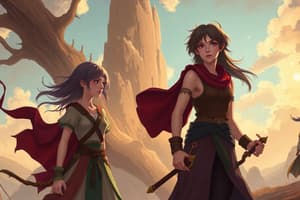Podcast
Questions and Answers
What is an essential characteristic of dynamic characters in a story?
What is an essential characteristic of dynamic characters in a story?
- They are characterized by only one or two traits.
- They experience a permanent change due to circumstances. (correct)
- They are easily summed up in a single sentence.
- They remain unchanged throughout the narrative.
Which of the following best describes indirect characterization?
Which of the following best describes indirect characterization?
- The author provides explicit details about a character's emotions.
- The character's traits are revealed through their actions and reactions. (correct)
- The character's thoughts are directly shared with the reader.
- The author describes a character's background in detail.
What distinguishes a first-person point of view from other narrative perspectives?
What distinguishes a first-person point of view from other narrative perspectives?
- It is told from an omniscient narrator's perspective.
- It uses personal pronouns like 'I' and 'you.'
- It contains the thoughts and feelings of multiple characters.
- It reflects only one character's perspective using personal pronouns. (correct)
Which type of conflict is classified as 'Man v. Self'?
Which type of conflict is classified as 'Man v. Self'?
In which narrative perspective does the narrator specifically avoid sharing any character's inner thoughts or feelings?
In which narrative perspective does the narrator specifically avoid sharing any character's inner thoughts or feelings?
What distinguishes flat characters from round characters?
What distinguishes flat characters from round characters?
What is a defining feature of the second-person point of view?
What is a defining feature of the second-person point of view?
In storytelling, what is the role of the antagonist?
In storytelling, what is the role of the antagonist?
Which point of view allows for insight into the thoughts and feelings of multiple characters?
Which point of view allows for insight into the thoughts and feelings of multiple characters?
What is a common characteristic of unreliable narrators in first-person narratives?
What is a common characteristic of unreliable narrators in first-person narratives?
Study Notes
Point of View Notes
- First Person Point of View involves a character narrating the story, using personal pronouns like I, me, my, and ours.
- This perspective can include unreliable narrators, who may lie or have mental issues, affecting the story's trustworthiness.
- Second Person Point of View engages the reader directly as the protagonist, identified by the pronoun "you," commonly used in instructional texts or adventure stories.
- Third Person Point of View can be either limited or omniscient:
- Limited Third Person: An external narrator describes the story without sharing the internal thoughts of characters, focusing on actions and sensory details.
- Third Person Omniscient: The narrator shares the internal thoughts and feelings of one or more characters, creating connections with the audience.
Characterization Notes
- Characters display motivations that explain their actions, enabling readers to understand behavior changes by the story's conclusion.
- Flat Characters possess one or two traits; easily summed up in a sentence, lacking complexity.
- Round Characters are complex and multi-faceted, often requiring extensive analysis to understand fully.
- Static Characters remain unchanged throughout the narrative, maintaining the same personality from beginning to end.
- Dynamic Characters experience significant change in personality or outlook, influenced by their circumstances and given sufficient time to evolve.
- The Protagonist is the main character around whom the story centers, while the Antagonist opposes this character.
- Direct Characterization reveals character details through explicit descriptions provided by the author.
- Indirect Characterization is shown through actions, thoughts, effects on others, speech, and appearance, summarized by the acronym STEAL.
Conflict Notes
- Conflict refers to the clash between opposing forces in a narrative, essential for story development.
- Internal Conflict occurs within the protagonist, often involving struggles like identity or moral dilemmas, typically summarized as Man vs. Self.
- External Conflict involves the protagonist facing outside forces, categorized as:
- Man vs. Man: Rivalry, competition, or social disagreements.
- Man vs. Nature: Struggles against environmental challenges or wildlife.
- Man vs. Supernatural: Encounters with mystical entities or concepts.
- Man vs. Machine: Conflicts relating to technology or machinery.
Studying That Suits You
Use AI to generate personalized quizzes and flashcards to suit your learning preferences.
Description
Explore the various points of view used in literature, including first person, second person, and third person perspectives. Dive into characterization techniques that help readers understand motivations and changes in characters throughout stories. Test your knowledge on these fundamental literary concepts.



